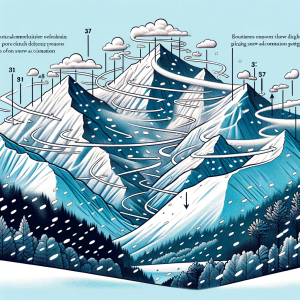
Floating into the Future: High-Altitude Balloons Are Revolutionizing Remote Sensing
Imagine a future where lightweight, solar-powered balloons drift high in the sky, providing internet access to remote villages, monitoring wildfires in real-time, or offering persistent surveillance over critical regions. Sounds like science fiction, right? In fact, this future is closer than we think, thanks to new research that’s helping scientists crack the code for controlling high-altitude balloons, which float miles above us in the stratosphere.
But here’s the catch: these balloons don’t have engines to propel them sideways like an airplane. Instead, they rely on something far more unpredictable—wind. And not just any wind, but layers of wind moving in different directions at different altitudes. The challenge has been figuring out how to steer these balloons effectively using just vertical control—going up or down—while being pushed sideways by the wind.
It might sound not very easy, but the potential is enormous. So, how does it all work, and why does it matter? Let’s float into this incredible research to find out how it’s helping balloons station-keep—stay in one place over a target—for extended periods, opening up a world of possibilities.
Balloons with a Mission
Before we get into the science, let’s talk about why controlling high-altitude balloons matters. These balloons have some distinct advantages over satellites and other airborne systems. They’re cheaper to launch, can stay aloft for long periods, and can be deployed relatively quickly. Plus, because they float much lower than satellites, they offer higher-resolution imaging and faster communication speeds.
Companies like Google Loon and World View have already demonstrated the potential of these systems, using them for things like remote internet access and environmental monitoring. However, one of the biggest challenges has been keeping these balloons over a specific area—something known as “station-keeping.”
This new study takes a deep dive into the ability of high-altitude balloons to station-keep in different parts of the world, using only wind patterns to navigate. Spoiler alert: it’s not as simple as floating up and down.
Winds of Change: The Key to Control
Think of the atmosphere as a giant layer cake, where each layer of frosting is a different wind speed and direction. Depending on the season, geographic location, and altitude, the wind might be pushing east, west, north, or south. The trick for the balloon is to “surf” these layers by moving up or down to catch a favorable wind that takes it closer to its target.
The researchers behind this study ran thousands of simulations to explore how well balloons could stay within 50 kilometers of a target location—something critical for consistent communication or surveillance. The findings were fascinating. While some regions, especially near the equator, offer ideal conditions for station-keeping year-round, other areas, like midlatitudes, pose significant challenges.
Why Midlatitudes are Tricky
Midlatitudes, which include much of the U.S. and Europe, are known for their variable weather patterns, which make station-keeping especially difficult. In these areas, the wind speeds and directions change rapidly with altitude, creating fewer opportunities for the balloon to catch the right breeze. As a result, balloons in these regions struggle to stay on target for more than a few hours.
Conversely, equatorial regions benefit from more predictable wind patterns. Here, balloons can often stay within their target zone for several days, making these areas prime candidates for early high-altitude balloon deployments.
Seasons Matter, Too
It’s not just geography that affects station-keeping—seasons play a big role, too. The study found that summer tends to be the best season for keeping a balloon on target, while winter poses more challenges, especially in the mid-latitudes. This is due to the way stratospheric winds shift with the seasons. In the summer, the winds are generally more favorable for station-keeping, while in the winter, the winds become more erratic and harder to navigate.
Why This Matters Now
So, why should we care about high-altitude balloons and their ability to stay in one place? The real-world implications are staggering. Imagine being able to set up a communication network over remote areas without the need for expensive satellites or ground infrastructure. High-altitude balloons could also be used to monitor environmental disasters like wildfires or oil spills in real-time, providing critical information to first responders.
And it’s not just about disaster response or internet access. These balloons could revolutionize fields like agriculture, where consistent aerial monitoring could help farmers optimize crop yields, or even in wildlife conservation, where they could track animal movements across vast areas.
The Future of High-Altitude Balloons
This research shows that while universal station-keeping—where balloons can hover over any location at any time—isn’t yet possible, we’re getting closer. By understanding the wind patterns and how they change with the seasons and geography, scientists can predict where and when station-keeping is most viable. This means we could soon see networks of balloons providing continuous coverage over specific regions, filling gaps left by satellites.
Of course, there are still challenges ahead. For one, controlling these balloons without using too much energy remains a key hurdle. While the balloons can already stay aloft for hundreds of days using solar power, maintaining precise control over long distances will require even more sophisticated algorithms and perhaps some limited propulsion systems.
Join the Conversation
What do you think about the future of high-altitude balloons? Could they really replace satellites for certain tasks, or are there limitations we haven’t yet considered? How would you feel about using a balloon-based network for your internet access or weather monitoring?
Drop your thoughts in the comments below and share this blog with anyone who might find it fascinating!
Join the Science Adventure
Stay updated with the latest discoveries in science! Our weekly newsletter is perfect for teachers and science enthusiasts. Get the newest research, major breakthroughs, and fascinating stories delivered to your inbox for free. Enhance your teaching and learning. Subscribe today! If you liked this blog, please share it! Your referrals help This Week in Science reach new readers.



